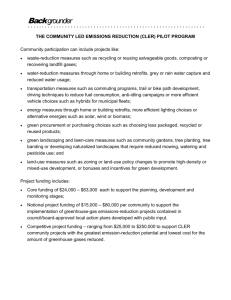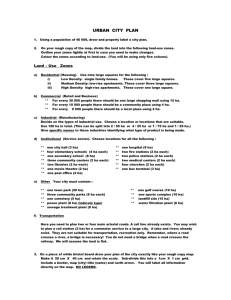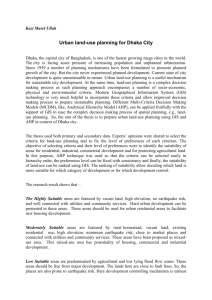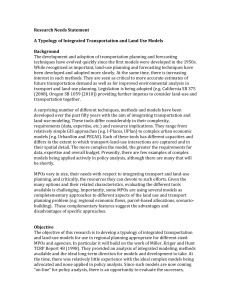DIGITAL MAPPING TO ASSIST RESIDENTIAL ... USING LANDSAT DATA
advertisement
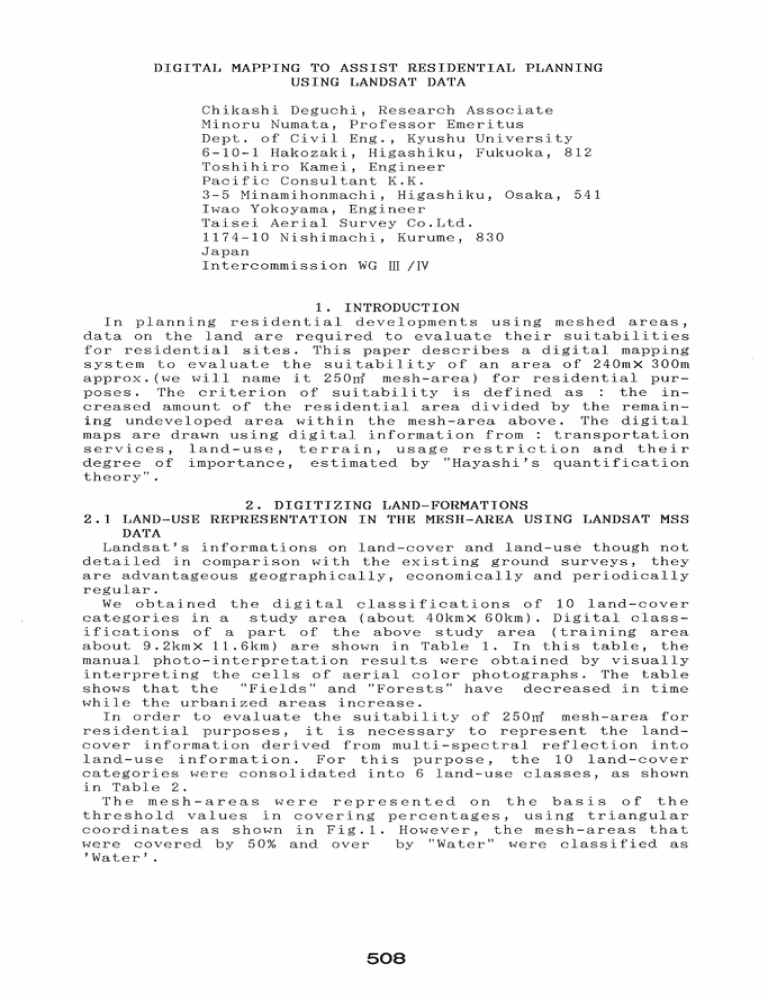
DIGITAL MAPPING TO ASSIST RESIDENTIAL PLANNING
USING LANDSAT DATA
Chikashi Deguchi, Research Associate
Minoru Numata, Professor Emeritus
Dept. of Civil Eng., Kyushu University
6-10-1 Hakozaki, Higashiku, Fukuoka, 812
Toshihiro Kamei, Engineer
Pacific Consultant K.K.
3-5 Minamihonmachi, Higashiku, Osaka, 541
Iwao Yokoyama, Engineer
Taisei Aerial Survey Co.Ltd.
1174-10 Nishimachi, Kurume, 830
Japan
In t e r co mm iss ion WG III / IV
1. INTRODUCTION
In planning residential developments using meshed areas,
data on the land are required to evaluate their suitabilities
for residential sites. This paper describes a digital mapping
system to evaluate the suitability of an area of 240mX 300m
approx.(we will name it 250~ mesh-area) for residential purposes. The cri terion of sui tabili ty is defined as
the increased amount of the residential area divided by the remaining undeveloped area wi thin the mesh-area above. The digi tal
maps are drawn using digital information from: transportation
services, land-use, terrain, usage restriction and their
degree of importance, estimated by "Hayashi's quantification
theory".
2. DIGITIZING LAND-FORMATIONS
2.1 LAND-USE REPRESENTATION IN THE MESH-AREA USING LANDSAT MSS
DATA
Landsat's informations on land-cover and land-use though not
detailed in comparison with the existing ground surveys, they
are advantageous geographically, economically and periodically
regular.
We obtained the digital classifications of 10 land-cover
categories in a
study area (about 40kmX 60km). Digital classifications of a part of the above study area (training area
about 9.2kmX 11.6km) are shown in Table 1. In this table, the
manual photo-interpretation results were obtained by visually
interpreting the cells of aerial color photographs. The table
shows that the
"Fields" and "Forests" have decreased in time
while the urbanized areas increase.
In order to evaluate the suitability of 250~ mesh-area for
residential purposes, it is necessary to represent the landcover information derived from multi-spectral reflection into
land-use information. For this purpose, the 10 land-cover
categories were consolidated into 6 land-use classes, as shown
in Table 2.
The mesh-areas were represented on the basis of the
threshold values in covering percentages, using triangular
coordinates as shown in Fig.1. However, the mesh-areas that
lv-ere covered by 50% and over
by "Water" were classified as
'Water'.
508
Table.1
Percentages(%) of Land-Covers in The Training Area
(derived from reference 1)
Photo
MSS Digital Classifications
Land-Cover Categories
1981
Nov.
1979
Sep.
I
I
I
I
21. 81 \ 24.48\ 24.65\ 25.21 1 24.73
3.37
3.35
3.50
3.11
3.03
9. 04 1 10.93 • 10.91 I 10.41 I 9.77
8.87
8. 71 10.07
9.45 , 9.30
4.59
5. 78 1 7.551 7. 64 1 8.34
4.53
4.65
3.26
5.07
5.28
6.64
7.00
6.31 I 6. 54 1 5.21
9.51
8. 72
8.54
11.86
8.69
10.56
9.85 \
9.441 9.12 1 9. 17
14.50 15.13 15.60 14.83 16.40
I
CD "Water 1"
@ "Water 2"
@ "F ie Ids"
@ "Forests"
(§) "0 pe n Land"
(§) "Waste Land"
(J) "Wild Field"
CID "Industrial Areas"
(ID "Urban Areas"
@) "Suburban Areas"
I
I
I
'Water'
'Fields'
'Forests'
'Waste Land'
'Urban Areas'
'Suburban Areas'
I
I
I
I
I
of arerial color photographs
Classes for Representing 250m
Mesh-Areas' Land-Use
Consolidated Land-Cover Categories
CD"Water I" (V"Water 2"
(ID" Fi eIds"
I
@"Forests"
(§)" apen Land" (§)" Wa s t eLand" (J)"W i I d Fie I d"
CID"Industrial Areas" @"Urban Areas"
d])"Suburban Areas"
( Deve loped Areas)
( Undeveloped Areas)
100
0
100
0
0
100
60
c
a
b
c
I
1
Land-Use Classes
1
2
3
4
5
6
I
I
= Visual-interpretation
Table.2
I
I
I
I
Photo
1984
Nov.
1981
Nov.
Oct.
....
....
e
Undeveloped Areas(d+e+f)
'Urban Areas'
'Suburban Areas'
Fig.1
0
100
40 60
d
e
f
'Fields'
'Forests'
'Waste Land'
Triangular Coordinates Used for Representation
509
Plate 1 shows 250~ mesh-areas' land-use using, Fukuoka city
and its suburbs as, a part of the study area. It is seen that
'Fields(o)' and urbanized areas(@,#) are intricately mixed in
the eastern region.
In this region,
there are difficulties
in harmonizing the agricultural and urban usages for planners.
'Forests 1 (+)' sho1·Yn in Plate 1 are the mesh-areas that are
not only represented by 'Forests', but also by less than
the
average altitude of 150m, and below
the maximum gradient
of
15°
'Forests 2' are all other than 'Forests 1'.
A
##@if +oott++++++++++++++++
ff" QQQQ++++++++-::::t+:t++o
H#
+Q+++ttOQ 0 ++:
OOOOM ::t:QO,,"'+++tt#+
OOOOOOQ+
0 ++----++,,1 t
+++
Q 10000+++ OQ+++++--+++--i+ ~ti###I~ Q + OO##OQ:QO ,,: tt--+------tAO ### "QQ"A tt+ttOO++ 0 ++--+----t + 000
+++++++ott+++++++--+------+MI#U H+ti IA:ttttA::t±+t#+++++--+---------to#o #i
+ +++tt + ++++++++---------++#QQO+ ~I+o AA +H++++++++;t+++++------- ---++##0 0## #ti tt++++AA" 0++# +H-------------A :±+##@#
#+++++++t++tt+" H++----------,,0 «
-----+--++++++----------00 "QQO#
+----Q+++ 0
H---++++++ tt++---- ++----00 A "##+
___ +~" +++++"++_+_ - ____ _
AA Q++n
+++ ___ O+++++QQ#++--M____ _
"QO:"'OA"A#
++++++---Q:++"" #++---@---+ + OQO
++--+ OQO+++++++#------0##00# O@
+0 AA +++-----#n#
+00+0+ tt----@o
000#000+++++----
~~iU~oooooo,..#""A+++++++----
+-
A
+--+
+o"+-tt
A
f'+---Aotil~:t;;:;;@+
AA
A
"+H--+"#
HH+"+--H
+--+
~++---H+++"oo
+-+
"+++++tt++++++
tt+tt+-tt+-tttt
0"" o+-----tt--+"
o"ttoAA~--"+---"tt
oott-tttt-" H+"o A" +tttt ~ tt
0++-++"+--#++++-0"+0 @roA +-Qtttt++++-tt+o 00000" o#o##Ho
"++++++++++++++0000#
#+
QQA t+++Htttt AQOOOQ#Qo A
" + +t:ttttt 0 000 0 o#o#tH
0+"Q "t±." 00000000000000
000 +
0000000000000#00 «@# +
OOO"OOMMOOOOOOQoooooooQoooo@ti"
0QooooooooooOQOQ" 00####+ o#QoQ Q",,' ..•"." ....
t OQQQOOQoooo Q OOOOQ++Qtt +
0# 00 oooQ# 00000+ tt +++++OQ +"oo:«@##@tIoo oOQQooo"tt++----tt
OOQ #@ifo~~ooooo ooo+++-------+++-I-+H·....I1,"·
QQ +tto# A:" 0000000" Oo+tt+------++--- ......... , ~ lL U.o ~
+ttQo+ QOOOOQOOOOQott++------+---tto +Qot QOO+"QOQO ott:tH -------·---H +
++Q" ++ + LQoo"" 0"QQOOO +:1: tt---------+-·
OQ ++++++ 00 0 ooooQ +H++-·---·------()('l
tt +++tt+++'" tooo+" Q" HooQoo "+-+++-------·--OO----------l1lflfl··fl+··++-~-----+H
"Q:++:+++:ttooo:""Q Qo,..rQO+t'--- -------ooot""""OQM +-+++----+
++ +t +:::L OOQ"O "0,,0,, +0 t·----- --++t+OOOQOQ"
++OQQ ++ oQo +0 + + ++tt+ ----------- ++++ Q tt++++---------+H·+T1-++-·~~"U~I'lig:""JL
"" + ++++-0+ ++++++++" ++++++_·++------------+++tt "" tt------------------+----A
A
A
°"
U"
A.'.
" .. ::: Water
-
M
0:::
Fields
t
==
Forests 1 -:: Forests 2
Plate.l
Land-Use of
A
'"'
Open Land
250~
@:::
Urban Areas
#::: Suburban Areas
Mesh-Areas
2.2 TRAFFIC ACCESSIBILITY
Traffic accessibility is an important factor that closely
influences land-use. Using cars and trains as means for traffic accessibility within the mesh-areas, we are determining
the shortest time-distance to center of the ci ty, and define
it as the traffic accessibility of the mesh-area. The road
network was composed of 135 link-roads stemmed from 83 junctions. The time-distance was calculated by the following
procedures:
l)Plotting the locations of the junctions into UTM coordinates
by a personal computer and a digitizing unit,
2)The average speed of the link-roads used were derived from
1
an existing traffic census,
3)Calculating the distance between the junctions of link-road
and putting it into time-distance. Then editing these data on
to disk-files,
4)Calculating the shortest route from every junction to the
center of the city,
5)Time-distance is the shortest time on the road calculated by
: case 1, mesh-areas on a link-road with one junction: either
the shortest distance in time between the junction to the next
junction in one direction plus the distance from that junction
to the center of the city or the distance from the junction
within the mesh-area to the other junction in the opposite
direction plus the distance from this junction to the center
of the city; depending on the shortest of the above two.
Case 2 where there is no junction within the mesh-area, center point of the road is taken as starting point and calculated as in case 1,
6)Shortest time-distance for mesh-areas not located on a linkroad is calculated by : access time from mesh-areas' center to
the nearest link-roads in four opposi te directions (using
slowest speed taken from existing census ) then adding them to
the above procedures of 4 and 5.
While for railway, time is derived from operational
timetables. Therefore, time-distance for mesh-areas located on
stations can be calculated by the same way as by road.
We assumed access time to the station within 3 km radius to be 2
minutes per 250~ mesh-area. Therefore the time-distance by
train is determined by adding
access time to the station,
line's operation time and time from the egress station to the
center of the city.
We have defined the shorter one of these time-distances in
terms of minutes, as the traffic accessibili ty of the meshareas.
2.3 TERRAIN
In Japan, altitude data of 250~ mesh-areas' intersecting
grid points are derived from
"National Digital Information
on Land". Therefore, we calculated the average altitudes of
the mesh-areas using it's four corners from the data obtained
above. While, the six gradients of each mesh-area were calculated by dividing the difference of two corners' altitude with
the distance between them. And 1·..,7e named the greatest one of
the six gradients as the maximum gradient.
2.4 LAND-USE RESTRICTION
Usually, data on the coverages of land-use restriction have
been supplied by conventional maps. The map has an advantage
of representing a lot of information. However, in order to
utilize its information for regional analysis, it is necessary
to put it into digital form. Here we present a practical way
of digitizing,
by using a personal computer and a digitizing
uni t. The digi tized land-use restrictions are shown in Table
3.
As boundary lines of land-use restrictions are usually complicated, it is necessary to represent approximately the
restricted areas into
polygons. We gave every corner of the
polygon an address on the grid shown in Fig.2. Fig. 2 shows an
11
example of a rOH (He named Lc) crossing tHO sides of the
polygon. One of these sides, betHeen corners Pi (Li J Ci) and
Pi + 1 (Li + 1 ,Ci + 1 ) ; its intersecting column Cc can be calculated
by the folloHing formula:
( Lc -Li )
- - - - - - ( Ci
(Li +1 -Li )
+
1
(1)
-Ci
Wh ere, Li f; Lc > Li + l o r Li < Lc S Li + 1
When He sort these column-addresses, He find all the rOHS
they intersect, crosses even number of sides and the
restricted areas lie Hithin the polygon's sides. Hence He can
identify the overall restricted areas by summing them up in
order of row-numbers. We
selected an area of 60mX 60m as our
uni t area for digi tizing. We represent the land-use restriction of 250nl mesh-areas by
the largest restricted part
Hithin each one of them.
Table.3
Digitized Restrictions of Land-Use
Land-use Restrictions
Description of Restriction
exclusively for urban usage
firgas.Promoted for
r anlzatlon
~reas Rgstricted
rom Ur anization
rreafl
or r blanned
anization
for urban usage with restrictions
Areas ~romoled for
Agricu tura use
for agricultural usage only
Unrestficte~
Drtignated as afric¥ltura~ areas, but
a owed to eve op or ur an usage
exclusively for forestry
Agricu tura Areas
Forest Areas
have potential for urban usage
Column
1 :2 3 4 5 6
1
:2 t-i--f-+-+-+-+3
4 I-+-+-+-+-+-+-
5
6
Fig.
2
Sides
I-+-f-+-+-+-+-
Addresses Used for Representing Land-Use Restrictions
3. DIGITAL MAPPING AND ITS USES
3.1 EVALUATION OF SUITABILITY FOR RESIDENTIAL AREAS
Usually, suitability has been evaluated by totalizing
predictive factors' points
given by
planning experts. HOHever,
12
planners still face the difficulty in evaluating
the importance of predictor factors and score points.
We are here proposing a method to evaluate the importance of
factors technically, based on ; Hayashi's quantification
theory I
In applying this evaluation theory for
suitability, the suitability must be numerically designated as
the criterion variable. We designated it as per formula below
and named it "Suitability Index{SI)". And we used the digital
data obtained in section 2 above as the predictor factors.
SI=
surface areas of new housing sites
surface areas of undeveloped grounds
x 100
(2)
Whereby, the surface areas of new housing sites were obtained
from existing 1979 and 1980 surveys (reference 2). We excluded
from the analysis the 250~ mesh-areas where within it more
than 1(ha) were sold. The undeveloped surface areas were obtained by adding the areas(pixels) classified as
"Fields","Forests","Open Land", "Waste Land" and "Wild Field"
in Table 1.
Table.4
Heading
PFedtctor
Traffic
Accessibility
time to
center
of city
Land-use
tr
I
Results from Hayashi's Theory
~fuJ
Landsat
information
1
< 30 min.
2 31 - 40
50
60
5 61 - 70
6 71 = <
1 'Fields'
2 'Forests'
Land-use
Restriction
92
130
I~
1
2
3
1
2
3
1
average
altitude
2
4
=<
0
0
2
- 4
0
0
=<
=<
20 m
21 - 40 m
41 m = <
Areas Promoted for
Urbanization
2 Areas restricted from
Urbanization
3 Areas Planned for
Urbanization
4 undesignated
1 Areas promoted for
AgriculAgricultural use
tural
2 Unrestricted
usage
Agricultural Areas
3 undesignated
Forest
1 Forest Areas
usage
2 undesignated
Constant term = 37.90
R
Urban
usage
67
28
96
80
181
44
142
418
56
69
298
141
104
318
8.71
0.37
0.82
2.56
- 3.02
-10.37
-11. 08
-10.24
- 6.37
I 21.69
14.66
0.16
- 0.43
- 0.61
- 0.12
0.12
0.19
5.96
134
-14.69
53
3.26
38
118
- 2.65
- 3.26
Il~~
'Waste Land'
'Urban Areas'
5 'Suburban Areas'
maximum
gradient
Topographical
Condition
Sam- Category
pIes Scores
Categories
I
0.62
Ranges
I 19.08
I
32. 77
O. 77
0.31
20.65
i
4.20
1
513
I
380
0.94
- 1.63
62
0.21
481
= 0.66
1. 84
Some of the neH areas' data may include, from land-use or
residential development planning vieH point, unsuitable sites,
due to lack of facilities or otherHise. HOHever, as the above
unsuitable sites' sale
occurred under existing economic or
social situations and land-use restrictions, the data gives us
important information regarding demand for preferred housing
development. In the above cases the SI means the potential of
mesh-areas for housing site usages, in consideration of the
trend or preference of demand.
Table 4 shoHs the scores estimated by the analysis. Though
the correlation coefficient is as IOH as 0.66, it gives
reasonable overall category scores.
As can be seen from the
ranges, land-use(32.77) strongly affects the SI-values. The
urbane usage(20.65) and the traffic accessibility(19.08) have
the same influences on them.
As the time-distances get longer, the category scores get
reasonably IOHer. Under heading
land-use ", the scores of
'Urban Areas' and 'Suburban Areas'(21.69,14.66) are high. Under urban usage, Hhile the category score of "Areas Restricted
from Urbanization"(-14.69) is the IOHest. This reveals that
their designation severely restrains the covered areas from
residential development.
II
3.2 DIGITAL MAPPING
In the above analysis, He used the predictor factors obtained in 1979-1980. HOHever, the opening of neH subHay and
the abolition of tHO railHay lines changed the traffic accessibili ties. Land-use restrictions had also been revised in a
part of the study area. We updated their digital data; extracted the land-use information from 1984 Landsat MSS data,
and neHly calculated 1984 SI using the above category scores.
Plate 2 shoHs a digital map for evaluating 250cl mesh-areas'
suitability for residential purposes (Suitability Index Map)
made by classifying the SI into various marked areas,
shoHn
beloH the map. Symbols "_If represent the areas more than
the
maximum gradient of 15° or the average altitude of 150m. Symbols "+" represent the mesh-areas classified as 'Urban Areas'
in the "Areas Promoted for Urbanization". We eliminated the
above tHO areas (-, +) from the evaluation, as nOHadays neH
residential developments are rarely feasible.
In this map, symbols H@" correspond to the areas designated
as "Areas Promoted for Urbanization" Hithin traffic accessibility of 30-40 minutes, "#" to areas Hithin 40-50 minutes.
n&" to areas Hithin 40 minutes (approx.), classified as
'Fields', 'Waste Land' or 'Forests'. They have not been
developed in spite of them being suitable. We can evaluate
their sui tabili ties, except for 'Forests', as Hell as the
areas symbolized by "@" and "#" above, only from the vielv
point of their effective investments in public-utilities.
Symbols "%11 correspond to areas Hithin 50 minutes and to
most of the areas over 0.5(ha) approx .. They have potential,
in the near future, for neH residential developments, especially these areas
adjacent to already developed ones. Symbols "*" and ":" correspond to the areas designated as "Areas
Restricted from Urbanization
We compared the Suitability Index Map of 1979 Hith a conventional map made by planning experts in 1978 (reference 3). In
ll
•
51
the latter map, they had used: land-use, traffic accessibility, gradient, soil and public facilities as predictor
factors and classified their suitabilities into five stages.
While, He obtained the SI as a continuous variable. We
evaluated their findings by testing the correspondence of superiori ty of tHO random points, betHeen both maps. The test
revealed that 75% of the 800 trials Here in agreement.
By using the Landsat data, the proposed method has the advantage of updating the land-use information Hhich plays an
important part in the evaluation. Therefore, the proposed
method reduces effort and cost in digital mapping in assisting
residential planning.
.................
...
~ ... :::::%
...............
*
~ < 10
60
# )= 50
: )= 10
& )= 40
%)= 30
)= 20
.. +" = Mesh-areas classified as • Urban Areas' in "Areas Promoted for Uabanizstion"
@ )=
" - " = Mesh-areas eli mi nsted
Plate.2
f rom eva 1uat ion
Suitability Index Map for Residential Purposes
3.3 SUITABILITY OF AREAS PLANNED FOR URBANIZATION
Zoning Hithin each administrative district(the study area
consists of 16 local administrative districts) consi ts of
draHing the boundary Hithin lands restricted from use, considering complicate circumstances of the particular locality.
Plate 3 shows a Suitability Index Map for evaluating
515
the suitabilities of "Areas Restricted from Urbanization".
Symbols "+" represent "Areas Promoted for Urbanization " and
symbols"
represent mesh-areas classified as 'Fields',
'Waste Land' and 'Forests'. They occupy approximately 40% of
"Areas Promoted for Urbanization
In the "Areas Restricted from Urbanization", A and B districts have relatively large SI-values. It may be required for
A district, as an airport is located in it, to be developed
for public usages rather than residential purposes. While,
from the view point of the public-utilities investment, it is
well to incorporate the B district into "Areas Promoted for
Urbanization "
11
If.
i
,,~
~~~tt""
tt
" $+ +++ :"':'"
~ t++++++++"'''
"
+tt""·"·· .".""
++++ttt++"M;""'''''': :":
ttt"""""'"''
...
++++++++,:." f L ' . :$:
++++tt· .........."
$
+++++tt...... ":"
:
tt+++t"
" . :
+++++:"""
"':
::
++++++H: : :
,,: $$:
++Ht:
::: ,:$
tHtH
' $$
t++I"H+ """,,:& :
tt++ itt
:: :
$ :
+t +++ "'++ &&
++&++t+ ++ ... """" :$$:
+++++++++++ + "" " $: : . ,
++++++t++++t
""
++++tttttt+H
$:
+tt+++++++++++
$
++++ +++H+H:
$
n
H++
+ ++:
: $
+
++
..
+++++
$ ... "
H+++++ttH
".
ttttH++H
HHH+t
+H : ++
+++++Htt
+HttttH+++
: +
t+++tttHtttt
t+++'I++++++++H
++++tt++++++++++H
AA"&" "
+ ++++++++Htt+++++
:"
HH++++Ht+H++++tt ~"
ttH
+H
+t+++++tt+H+HH::f.++,,~&:,,"" +++ : ~ tt""
tttt+tt+++++H++++
H :::: +H: :
ttH+HH+++H+HH+ "+"""" ~ : "
tt+tt+ttt
+ +tttt+tttttttt+++: +tttt: : +tt+H+++H+
+tt+tttt+++++++H ++++
. &: ::: :"
+ ++++tt+H++tt+H+tt++ +$:,
: :~: :&~$
tttt++H++H+++++H +~ 'I~~ n&
: :$$$
++ttt++++++H ++++H
~
: E
++++++++++H
++tttttt+ " +++H
+++++++++++tt
++++ H+ "
$ +++++
++++++++++++
+ ++++++ +
+++ &
+tt+++++tt++++
+ +++++++++ +++$
HttH++tt+++++
++tt+ +++++
tt
++++++++H+H+H
Htt +++H+
+++++++++++++++++
++++H+
+++++
+tt+tt+++++H++++++ + Htt H+++H+++++H
++++++++++++++++++++ H ++
++tt+++++ +
HH++++++++HHH++H+++
H+++++
++++++++HH++++++++H+++t+
+++
n ):: 40 &)= 30 $)= 20 :)= 10 "< 10
D
I
n)=
40
&)=
30
$)=
20
:)=
10
"
< 10
Areas Promoted for Urbanization
Mesh-areas class i f i ed as ' Fi el d' • • Waste Land' , , Forests'
i n the above " t "
Plate.3
Suitability Index
Map of "Areas
Restricted from
Urbanization"
" +" Areas Promoted for Urbani zat i on
Plate.4
516
Suitability Index
Map of "Unrestricted
Agricultural Areas"
3.4 SUITABILITY OF UNRESTRICTED AGRICULTURAL AREAS FOR
URBANIZATION
As "Unrestricted Agricultural Areas" are allowed for
development, not only for agricultural, but also for urbane
usages, planners face the difficulty in harmonizing both
usages, especially within "Areas Planned for Urbanization".
Plate 4 is Suitability Index Map of the "Unrestricted
Agricultural Areas". C, D and E districts have relatively
large values of SI. As C and D are already near developed
areas, they face less problem for residential development
rather than for agricultural purposes. While, D district is
away from existing "Areas Promoted for Urbanization". More
residential developments in this district require a large
amount of public-utilities' investment. As shown in Plate 1,
'Fields' of lower al ti tudes lie to its western region. This
discourages planners from further developments and they would
designate it as "Area Restricted from Urbanization", having
the lowest score(-14.69) as shown in Table 4.
Digital maps give us basic information to assist in designation of land-use restrictions and reveal some of the problem
areas that should be restrained from developments.
4. CONCLUSION
The characteristics of the digital mapping proposed and the
results are summarized as follows:
I)Hayashi's theory rationally gave us the predictor factors'
importance in evaluating the 250~ mesh-areas' suitability for
residential purposes.
2)The land-use information derived from Landsat data played an
important part of the evaluation.
3)The digital map gave us reasonable evaluation of the overall
suitability, same as the conventional manually-made one by experts.
4)From the digital maps, we can derive basic informations to
assist in designations of land-use restriction and planning
for residential development.
REFERENCES
1) Yokayama I. et. al.
Classification
Based
of
Land-Cover
on Statistical Verification, Kyoto ISPRS Congress, WG IV ,
1988.
2)Development Planning Department of Fukuoka Prefecture: Surveys of Land-Use Trend, 1980-1984.
3)Development Planning Department of Fukuoka Prefecture
Evaluation Map for Possibilities of Residential Development,
1978.
517


